
 Media Center
Media Center

Lingqu Canal [Photo provided by Wang Zhanfei]
On Feb 21st, Lingqu Museum successfully joined the Inland Waterways International (IWI).
Situated in Xing'an county, Guilin city, the museum is a comprehensive historical and cultural institution that encompasses cultural relics, valuable research, social education, exhibition, and the promotion of Lingqu culture.
Lingqu Museum, through its specialized exhibitions titled "Lingqu Culture Display" and "Chronicles of Ancient Town", presents a three-dimensional portrayal of Lingqu Canal, the most significant cultural heritage site in Xing'an.
The museum vividly showcases the profound influence of Lingqu Canal in fostering crucial political, economic, and cultural integration between the Central Plains of China and Lingnan (South China).
It highlights Lingqu Canal's role as not only a vital link for the nation’s unity and communication of Chinese civilization but also a critical passageway through which the ancient Maritime Silk Road accessed the Central Plains of China.
The exhibitions effectively convey the vital role and significance of Lingqu Canal in shaping the development of Chinese history and culture, as well as its contributions to global cultural exchanges.
Lingqu Canal, as one of the world's oldest man-made canals, shares the distinction of being one of the three major water conservancy projects of the Qin Dynasty (221 to 206 BC), alongside Dujiangyan in Sichuan and Zhengguo Canal in Shaanxi.
It has garnered the reputation of being a luminous gem among ancient hydraulic architectural marvels. It serves essential functions in agricultural irrigation and flood control even today.
Lingqu Canal was designated as a key national cultural heritage conservation unit by the State Council in 1988. In 2018, it was inscribed on the World Irrigation Engineering Heritage List, and in 2021, it was included as one of the fourth batch of national water education bases.